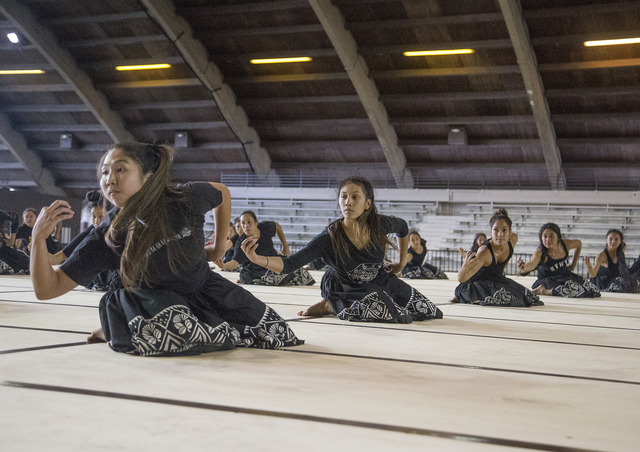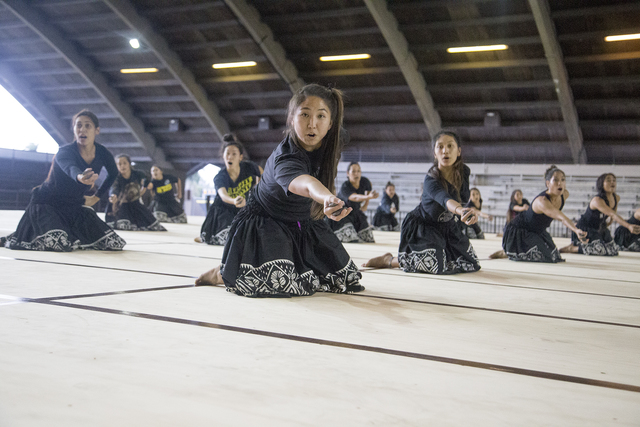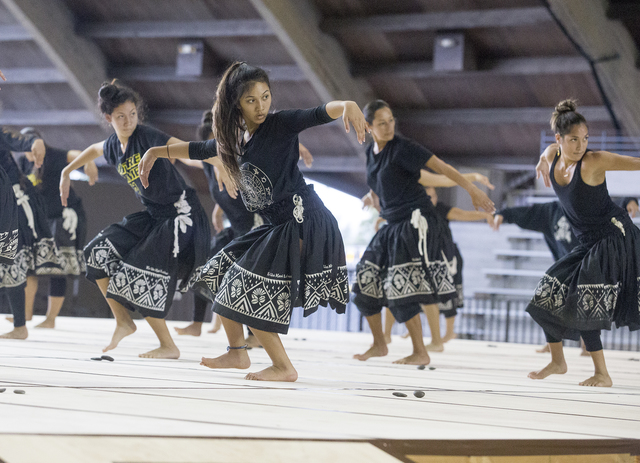For more than four decades, kumu hula Johnny Lum Ho has created excitement at the Merrie Monarch Festival.
His Halau O Ka Ua Kani Lehua is always a fan favorite — win, place or show. The buzz is palpable whenever the Hilo halau competes in hula’s premier competition, even though it’s been only three years since the halau last took the competition stage during the 50th anniversary festival in 2013.
Lum Ho is a seemingly inexhaustible creative force as a choreographer, haku mele (writer of songs and chants), ho‘opa‘a (chanter), singer, musician and bandleader.
“There’s so much passion in every single line that he composes. In every single word he writes, there’s a meaning,” said Kayshlyn Keauli‘imailani Victoria “Auli‘i” De Sa, who will represent the halau in the Miss Aloha Hula competition Thursday and is dancing in the wahine group competition for the third time.
Lum Ho has had his share of wins on the Merrie Monarch stage, starting with the second edition of the hula competition in 1972, but there also have been years his halau has come away empty-handed during Saturday night’s awards ceremony after wowing the crowd.
“I’d rather please the crowd,” Lum Ho said. “You know why? They pay to come in. I just do what I feel excited about doing, and I just want my girls to get ready for that.”
“Our main goal is to entertain the people,” De Sa added.
The halau’s line of wahine ‘olapa (dancers) is young, said Kasie Kaleohano, an instructor in the halau.
“For a lot of them, it’s their very first time dancing in Merrie Monarch,” she said. “We only have a handful of old-timers — we call them ‘old-timers’ but they might be 25. That just means they’ve been in multiple Merrie Monarchs before. I think the younger girls are very, very dedicated. They really want this, and the caliber of dancing, I’d say, is good. But then again, so is everyone else’s caliber of dancing in Merrie Monarch.
“Our choreography tends to be a little more difficult, maybe a little bit more physically demanding. It’s tough. But they’ve been sticking it out, and I think they’ll do a great job.”
In Friday night’s hula kahiko (ancient hula) competition, the wahine will dance to “Honu Kea, Ka Honu Nui ‘o Moloka‘i.”
“It’s a chant about the white turtle of Moloka‘i,” Lum Ho said. “That story was given to me by Aunty Harriet Ne. She was well-known on Moloka‘i.
“The turtle lived on an island called Moku Hooniki in the waters off Cape Halawa. During the mating season, the turtle used to go all the way to Pelekunu Valley, where the people worshipped and hand-fed the turtle. Every time Honu Kea came to Pelekunu to lay her eggs, she brought a school of moi.
“My hula group did it in 1982, but I used the pahu (wood drum) then. This time, I’m using the ipu (gourd drum).”
It’s a story that’s worked before as Lum Ho’s halau won the kane kahiko, ‘auana and overall titles in 1982, as well as the overall group title.
Kaleohano said she thinks one reason Lum Ho’s dances resonate with audiences is one needn’t speak Hawaiian or be a hula expert to understand the meaning of the dance.
“If we’re telling a story about something, we want to make sure that you can tell what we’re talking about,” she said. “For instance, if one part of the kahiko talks about smashing up a puhi (eel) to feed to the turtle, you can only smash a puhi so many ways. It’s a little bit more demanding, a little bit more rough, because it’s realistic. And I think people like to be able to tell what the story’s about, and that’s why they respond to Uncle Johnny and the choreography.”
Lum Ho said his halau also will pay tribute to the more recent past, when sugar was king in Hawaii.
“Our ‘auana will be from the plantation days, when they used to import the workers from the Philippines, Japan and China to work in the cane fields. My girls will be showing through their hula how they worked in the cane fields,” he said. “They’re paying a special tribute to the Philippines and visiting the Filipino camp.”
The dancers will employ pu‘ili, split bamboo percussion sticks, in a hula homage to tinikling, the Filipino bamboo dance.
The music will be provided by the halau band with Lum Ho, Mark Yamanaka and Kaleo Kalauoka‘ae‘a-Kahele providing three-part falsetto harmonies, plus Bert Naihe on guitar and Eddy Atkins on electric bass.
And while some kumu shy away from hula styles that might be considered flashy or showy, Lum Ho embraces hula as entertainment. For a number of years, Kawelo Kong Kee was the halau master of ceremonies, providing English-language narration for the audiences in a manner reminiscent of Waikiki nightclub shows. Kong Kee’s health won’t allow him to take the microphone this year, so Chris Agpoon, a halau musician, will emcee.
Lum Ho’s halau didn’t place at the golden anniversary competition, despite a wildly enthusiastic response from the audience. There’s an entirely new set of judges this year, and although most kumu don’t want to comment about the judging, Lum Ho welcomed the change, saying the three judges who scored his halau the lowest gave him no constructive feedback in the comments section of their sheets. He also made it clear who his halau performs for.
“Everybody tells me they are excited to see us at Merrie Monarch. I can hardly wait to do what we do for the crowd. We do it for them.”
Email John Burnett at jburnett@hawaiitribune-herald.com.










